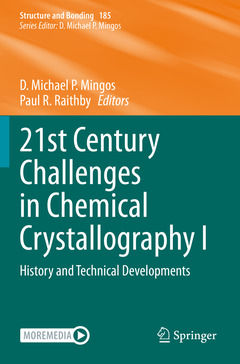21st Century Challenges in Chemical Crystallography I, 1st ed. 2020 History and Technical Developments Structure and Bonding Series, Vol. 185
Coordonnateurs : Mingos D. Michael P., Raithby Paul R.

This volume summarises recent developments and possible future directions for small molecule X-ray crystallography. It reviews specific areas of crystallography which are rapidly developing and places them in a historical context. The interdisciplinary nature of the technique is emphasised throughout. It introduces and describes the chemical crystallographic and synchrotron facilities which have been at the cutting edge of the subject in recent decades. The introduction of new computer-based algorithms has proved to be very influential and stimulated and accelerated the growth of new areas of science. The challenges which will arise from the acquisition of ever larger databases are considered and the potential impact of artificial intelligence techniques stressed. Recent advances in the refinement and analysis of X-ray crystal structures are highlighted.
In addition the recent developments in time resolved single crystal X-ray crystallography are discussed. Recent years have demonstrated how this technique has provided important mechanistic information on solid-state reactions and complements information from traditional spectroscopic measurements. The volume highlights how the prospect of being able to routinely ?watch? chemical processes as they occur provides an exciting possibility for the future. Recent advances in X-ray sources and detectors that have also contributed to the possibility of dynamic single-crystal X-ray diffraction methods are presented. The coupling of crystallography and quantum chemical calculations provides detailed information about electron distributions in crystals and has resulted in a more detailed understanding of chemical bonding.The volume will be of interest to chemists and crystallographers with an interest in the synthesis, characterisation and physical and catalytic properties of solid-state materials. Postgraduate students entering the field will benefit from a historical introduction to the subject and a description of those techniques which are currently used. Since X-ray crystallography is used so widely in modern chemistry it will serve to alert senior chemists to those developments which will become routine in coming decades. It will also be of interest to the broad community of computational chemists who study chemical systems.
The Early History of X-ray Crystallography.- Recent developments in refinement and analysis of X-ray crystal structures.- Leading edge chemical crystallography service provision and its impact on crystallographic data science in the 21st century.- Crystallographic analysis of crystals under high pressure conditions.- Watching Photochemistry Happen: Recent Developments in Dynamic Single-crystal X-ray Diffraction Studies.- Time Resolved Single Crystal X-ray Crystallography.
Michael Mingos was born in Basra, Iraq in 1944 and was educated in England (B.Sc. in Chemistry 1965) and University of Sussex (D.Phil, 1968). He has held academic posts at QMC, Oxford (Keble College), Imperial College, St Edmund Hall (Principal,1999-2009). His theoretical research has resulted in generalisations which have greatly influenced the development and teaching of modern inorganic chemistry. Specifically the Wade-Mingos Rules which rationalise the structures of polyhedral inorganic molecules and the Green-Davies-Mingos Rules, which account for some of the nucleophilic reactions of organometallic compounds. His group has experimentally verified some of his theoretical predictions, for example an icosahedral molecule containing gold atoms -which is relevant for understanding the metal’s nano-technological possibilities. He has also contributed to the understanding of the bonding properties of nitric oxide, an important cellular signalling molecule involved in many physiological processes and pioneered the acceleration of chemical reactions using microwave energy. He was elected the Royal Society in 1992 and the European Academy of Sciences in 2017. He holds honorary doctorates from Sussex and Manchester Universities and received many prizes – the most recent was the Blaise Pascal Medal in 2017.
Paul Raithby has been Professor of Inorganic and Structural Chemistry at the University of Bath since 2000. Prior to that he spent 25 years as a Faculty member in the Department of Chemistry at the University of Cambridge. He is a Fellow of the European Academy of Sciences (EURASC) and of the Royal Society of Chemistry. He has published over 860 refereed research papers and has given over 100 lectures at national and international meetings during his career. His current research focusses on coordination chemistry, the development of the chemistry of platinum poly-ynes as sensor materials, and he has pioneered the de
Highlights new types of crystallographic experiments
Interdisciplinary appeal that spans the physical sciences
Contributions from international experts
Date de parution : 01-2022
Ouvrage de 278 p.
15.5x23.5 cm
Date de parution : 01-2021
Ouvrage de 278 p.
15.5x23.5 cm



